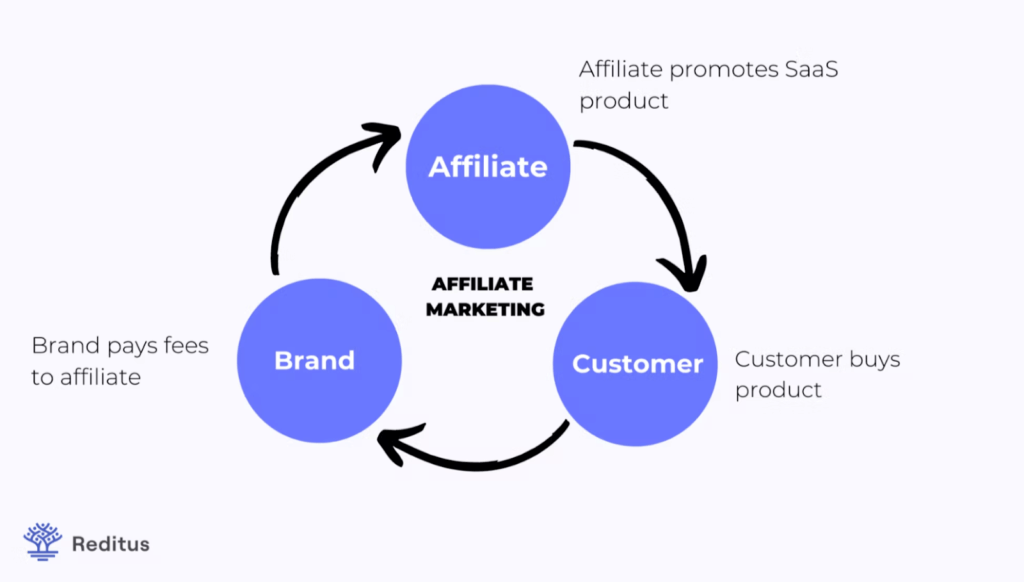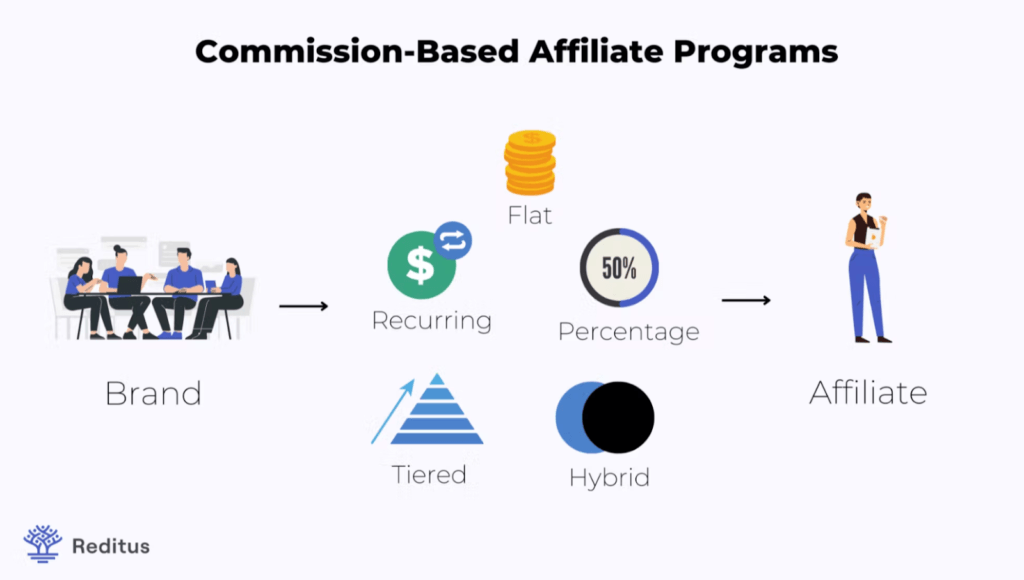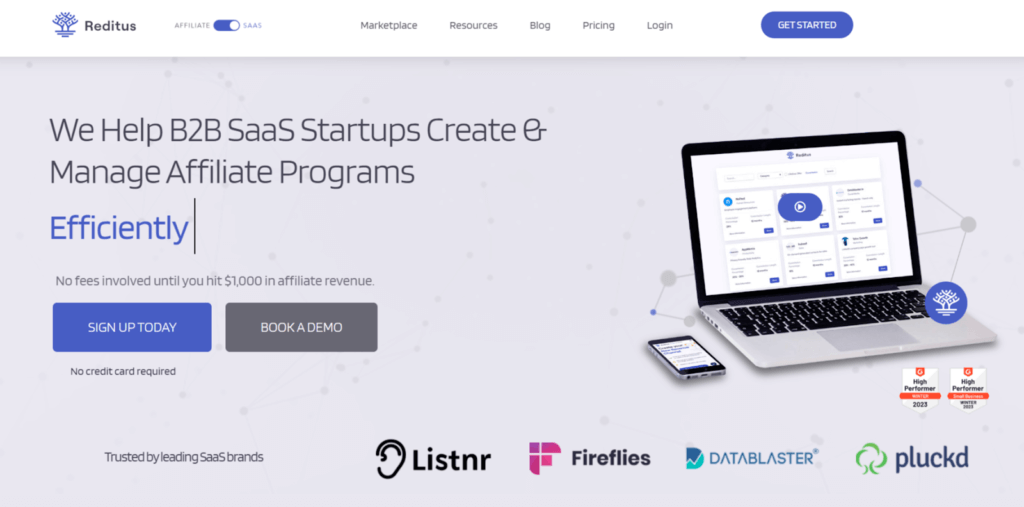The Beginner’s Guide to B2B Affiliate Marketing

Do you want to maximize your business's marketing potential, expand your reach to new markets, and improve customer loyalty without breaking the bank?
If the answer is yes, then B2B affiliate marketing might be the solution you've been looking for.
This beginner's guide will provide a comprehensive overview of B2B affiliate marketing and explain how it can benefit your business.
We will also cover the steps in setting up a successful affiliate program, the best practices for ensuring long-term success, and how to measure your return on investment (ROI).
Let’s dive in.
Table of contents
- What Is B2B Affiliate Marketing?
- How Can You Start a B2B Affiliate Marketing Program?
- What Are the Best Practices for B2B Affiliate Marketing Success?
- Best Practice # 1: Communicate Effectively With Affiliates
- Best Practice #2: Track and Analyze Affiliate Performance
- Best Practice # 3: Continuously Optimize Your Affiliate Program
- Best Practice # 4: Ensure Compliance With Regulatory Requirements
- Best Practice #4: Adopt the Right Affiliate Management Platform
- How Can You Measure the ROI of Your Affiliate Program?
- Conclusion
What Is B2B Affiliate Marketing?
B2B affiliate marketing is a performance-based marketing strategy businesses use to promote their products or services to other businesses.
In this model, affiliates (partners or publishers) promote a company's offerings to their audience in exchange for a commission on leads, sales, or other desired actions.

This approach helps businesses expand their reach, tap into new markets, and improve brand visibility while minimizing marketing costs.
Who Are the Key Players in the Affiliate Marketing Ecosystem?
There are several key players in the affiliate marketing ecosystem, including:
- Merchant: The company offering the product or service being promoted.
- Affiliate: The partner or publisher who promotes the merchant's products or services to their audience.
- Affiliate network: A platform that connects merchants and affiliates, streamlines the process of tracking and managing affiliate partnerships, and handles commission payments.
- Customer: The end user who purchases the merchant's product or service through the affiliate's referral.
What Are the Types of Affiliate Programs?
Not all affiliate programs are created equal.
You must tailor your program to your needs and objectives.
That said, some common types of affiliate programs include:
- Pay-per-sale: Affiliates receive a commission for every sale they generate.
- Pay-per-lead: Affiliates are rewarded for generating qualified leads, such as sign-ups, form submissions, or newsletter subscriptions.
- Pay-per-click: Affiliates earn a commission for each click they drive to the merchant's website.

What Are the Most Effective Affiliate Marketing Channels?
Affiliates can promote a company's products or services through various channels, including:
- Content marketing: Creating blog posts, articles, or reviews related to the merchant's offerings.
- Social media: Sharing promotional content, links, or offers on social media platforms.
- Email marketing: Sending targeted email campaigns to a subscriber list.
- Webinars and podcasts: Hosting or participating in webinars or podcasts to discuss the merchant's products or services.
- Influencer marketing: Partnering with industry influencers to promote the merchant's offerings.
What Are the Commission Structures and Payment Models Available?
Determining the right commission structure and payment model is crucial for the success of a B2B affiliate marketing program. This incentivizes affiliates to promote your products or services effectively and ensures that your marketing budget is well-spent.
Here are some common commission structures and payment models used in affiliate marketing:
- Flat-rate commission: Affiliates receive a fixed amount for every sale, lead, or click they generate. This model is simple and easy to understand, making it attractive for both affiliates and merchants.
- Percentage-based commission: Affiliates earn a percentage of the revenue generated from each sale they refer. This model is trendy in e-commerce and can be more motivating for affiliates since their earnings are directly tied to the value of the sales they generate.
- Tiered commission structure: This model offers different commission rates based on the affiliate's performance. For example, an affiliate might receive a higher commission rate after achieving a certain number of sales or leads within a given period. This approach incentivizes top-performing affiliates to continually improve their efforts.
- Recurring commission: Affiliates receive ongoing commissions for as long as the referred customer remains a paying customer. This model is standard in subscription-based services and can create a steady income stream for affiliates.
- Hybrid model: A combination of different commission structures or payment models can be used to address the specific needs of your business and your affiliates. For example, you might offer a flat-rate commission for each sale and a percentage-based bonus for hitting predefined performance targets.
When selecting a payment model, it's essential to consider factors such as your business goals, the complexity of your sales process, and the preferences of your target affiliates.
Additionally, ensure that your commission structure is competitive within your industry to attract and retain high-quality affiliates.
How Can You Start a B2B Affiliate Marketing Program?
The success of B2B affiliate marketing can be attributed to several factors, including the ability to create mutually beneficial partnerships, the inherent scalability of the model, and the focus on performance-driven results.
By establishing a strong network of affiliates, businesses can access new customers and market segments that may have been previously inaccessible.
Here are some steps to consider:
Step 1: Define Program Goals and Objectives
Before launching a B2B affiliate marketing program, it's crucial to establish clear goals and objectives. These will serve as a roadmap for your program and help you measure its success.
Some standard B2B affiliate marketing program plans include:
- Increasing brand visibility
- Generating leads
- Driving sales
- Expanding into new market segments
To set specific, measurable, achievable, relevant, and time-bound (SMART) objectives, consider the following:
- Identify your target audience: Determine the businesses or industries you want to target with your affiliate marketing efforts.
- Set performance targets: Establish quantitative targets, such as the number of leads or sales you aim to generate within a specific timeframe.
- Determine key performance indicators (KPIs): Identify the metrics you will use to evaluate the success of your program, such as conversion rates, average order value, or return on investment (ROI).
Step 2: Identify and Vet Potential Affiliates
Choosing the right affiliates is critical to the success of your B2B affiliate marketing program.
Look for partners with a strong online presence, an engaged audience, and a track record of promoting products or services in your industry. To identify and vet potential affiliates, consider the following steps:
- Research industry influencers, bloggers, or content creators relevant to your niche.
- Evaluate potential affiliates' website traffic, social media following, and engagement levels to ensure they have the reach and influence needed to drive results.
- Assess the quality of their content and promotional tactics to determine if they align with your brand's values and messaging.
- Check for existing partnerships with competitors or any potential conflicts of interest.
- Reach out to potential affiliates with a personalized proposal highlighting the benefits of partnering with your company and detailing your affiliate program's terms and conditions.
Step 3: Develop an Attractive Commission Structure
Creating a competitive and appealing commission structure is essential to attract and retaining high-quality affiliates.
When designing your commission structure, consider the following factors:
- Industry benchmarks: Research commission rates and payment models commonly used to ensure your program is competitive.
- Affiliate preferences: Some affiliates prefer flat-rate commissions, while others find percentage-based commissions more motivating. Consider offering a mix of commission structures to accommodate various preferences.
- Performance incentives: Implement tiered commission structures or performance-based bonuses to reward top-performing affiliates and motivate continuous improvement.
- Transparency and clarity: Clearly communicate the commission structure, payment terms, and other conditions to potential affiliates to build trust and set clear expectations.
- Flexibility: Be open to adjusting your commission structure over time based on affiliate feedback and performance data to optimize the effectiveness of your program.
Step 4: Provide Affiliates With the Necessary Tools and Resources
To ensure the success of your B2B affiliate marketing program, it's essential to equip your affiliates with the tools and resources they need to effectively promote your products or services.
Providing your affiliates with quality marketing materials and support increases the likelihood of generating leads, sales, and overall program success. Consider providing the following tools and resources to your affiliates:
- Promotional materials: Offer a variety of high-quality, ready-to-use marketing assets such as banners, images, videos, and email templates that affiliates can easily incorporate into their promotional efforts.
- Product information and training: Provide detailed product or service information and any necessary training or educational materials to help affiliates better understand your offerings and effectively communicate their value to their audience.
- Unique tracking links: Supply affiliates with individual tracking links or referral codes to accurately track their performance and ensure they receive credit for any leads or sales they generate.
- Reporting and analytics: Grant affiliates access to a user-friendly dashboard to view their performance metrics, track their earnings, and monitor their progress toward achieving their goals.
- Dedicated support: Offer ongoing support through a dedicated affiliate manager or the support team who can assist affiliates with questions or concerns and guide them on optimizing their promotional strategies.
Step 5: Launch and Manage Your Affiliate Program
Once you have defined your program's goals, identified and vetted potential affiliates, developed an attractive commission structure, and provided the necessary tools and resources, it's time to launch and manage your B2B affiliate marketing program.
Here are some critical steps to help you do it:
- Recruitment: Reach out to potential affiliates with a personalized proposal, and invite them to join your program. Utilize various channels such as email, social media, or industry events to connect with potential partners.
- Onboarding: Facilitate a smooth onboarding process by providing clear instructions on how to get started, access promotional materials, and use tracking links or referral codes.
- Ongoing communication: Regularly communicate with your affiliates through email updates, webinars, or one-on-one calls to share program news, offer performance insights, and address concerns or questions.
- Performance monitoring: Continuously track your affiliates' performance using the KPIs and metrics you established during the goal-setting phase. Identify any areas for improvement and work with your affiliates to optimize their promotional efforts.
- Compliance: Ensure that your affiliates adhere to relevant industry regulations or guidelines, such as proper disclosure of affiliate relationships and data privacy laws.
- Periodic review: Regularly assess the overall performance of your affiliate program and make any necessary adjustments to your commission structure, promotional materials, or affiliate roster to optimize the program's effectiveness and achieve your goals.
What Are the Best Practices for B2B Affiliate Marketing Success?
To maximize the potential of your B2B affiliate marketing program, it's essential to implement best practices that foster strong relationships with your affiliates, ensure consistent communication, and enable data-driven decision-making.
By following these best practices, you can increase the likelihood of long-term success for your business and affiliate partners.
Best Practice # 1: Communicate Effectively With Affiliates
Effective communication is vital to building and maintaining successful affiliate partnerships.
By keeping affiliates informed and engaged, you can help them better promote your products or services and drive the desired results.
Here are some tips for effective communication with your affiliates:
- Establish a regular communication schedule: Send regular email updates or newsletters to inform your affiliates about program news, promotions, product updates, and other relevant information.
- Offer personalized support: Provide dedicated support through an affiliate manager or support team who can answer questions, address concerns, and offer guidance on promotional strategies.
- Encourage two-way communication: Create an environment where affiliates feel comfortable sharing their feedback, ideas, or challenges, and be responsive to their input.
- Organize webinars or training sessions: Host regular webinars to educate your affiliates about your products or services, share best practices, and discuss industry trends.
- Create a dedicated affiliate portal or forum: Offer a centralized platform where affiliates can access promotional materials, track their performance, and communicate with your team or other affiliates.
Best Practice #2: Track and Analyze Affiliate Performance
Monitoring and analyzing your affiliates' performance is essential for optimizing your B2B affiliate marketing program and achieving your goals.
By tracking key performance indicators (KPIs) and conducting regular performance analyses, you can identify areas for improvement and work with your affiliates to optimize their promotional efforts.
Here are some steps to effectively track and analyze affiliate performance:
- Set clear KPIs: Establish the KPIs you will use to measure your affiliates' performance, such as conversion rates, click-through rates, average order value, or ROI. These should align with your program's overall goals and objectives.
- Implement robust tracking tools: Utilize reliable tracking software or tools to accurately monitor your affiliates' performance. Ensure that unique tracking links or referral codes are used to attribute leads or sales to the correct affiliates.
- Provide affiliates with performance data: Grant them access to a user-friendly dashboard to view their performance metrics, track their earnings, and monitor their progress. This will help them understand how well they are performing and where to improve.
- Conduct regular performance reviews: Periodically review your affiliates' performance data to identify trends, areas for improvement, and best practices. Share these insights with your affiliates and collaborate on strategies to optimize their promotional efforts.
- Test and optimize: Encourage your affiliates to continually test and optimize their marketing tactics based on performance data. This may include experimenting with different content formats, promotional channels, or messaging to identify the most effective strategies for driving results.
- Reward high-performing affiliates: Recognize and reward your top-performing affiliates with higher commission rates, bonuses, or other incentives. This can motivate them to continue delivering exceptional results and foster loyalty to your program.
By effectively communicating with your affiliates, tracking their performance, and using data-driven insights to optimize your program, you can significantly increase the likelihood of long-term success for your B2B affiliate marketing efforts.
Best Practice # 3: Continuously Optimize Your Affiliate Program
To ensure the ongoing success of your B2B affiliate marketing program, it's crucial to regularly evaluate and optimize its various components.
Continuous optimization enables you to stay ahead of market trends, adapt to changes in your industry, and maximize your program's effectiveness. Here are some strategies for continuously optimizing your affiliate program:
- Monitor industry trends: Keep an eye on emerging trends, technologies, and best practices within your industry and the broader affiliate marketing landscape. Incorporate relevant innovations into your program to stay competitive and drive better results.
- Evaluate your commission structure: Periodically assess it and make adjustments as needed to ensure it remains attractive and competitive. Consider offering performance-based incentives or tiered commission rates to reward top-performing affiliates.
- Update promotional materials: Regularly review and update your promotional materials to ensure they remain fresh, engaging, and relevant to your target audience. Provide your affiliates with diverse assets to suit different promotional channels and formats.
- Analyze performance data: Use the performance data collected from your tracking tools to identify areas for improvement, high-performing strategies, and potential growth opportunities. Share these insights with your affiliates and work together to optimize their promotional efforts.
- Assess affiliate roster: Continuously evaluate your roster of affiliates to ensure they remain a good fit for your program. Be open to recruiting new affiliates who can bring additional value, expertise, or reach to your marketing efforts.
Best Practice # 4: Ensure Compliance With Regulatory Requirements
To maintain the integrity and legality of your B2B affiliate marketing program, ensuring compliance with relevant regulatory requirements is essential.
This may include adhering to advertising guidelines, data privacy laws, and proper disclosure of affiliate relationships.
Some steps to ensure compliance include:
- Provide clear guidelines: Communicate any relevant legal and regulatory requirements to your affiliates, and provide clear guidelines on how to comply with them.
- Implement monitoring processes: Establish processes to monitor your affiliates' promotional activities and ensure they adhere to the required regulations and guidelines.
- Offer support and resources: Provide your affiliates with the necessary resources, such as disclosure templates or privacy policy guidance, to help them comply with regulatory requirements.
- Take corrective action when needed: In cases where affiliates fail to comply with regulations, promptly address the issue and take disciplinary action, such as providing additional training or, if necessary, terminating the partnership.
Best Practice #4: Adopt the Right Affiliate Management Platform
Managing an affiliate program is daunting.
To streamline your affiliate marketing operations and optimize your processes, you must embrace technology.
Here’s where Reditus comes into play.
Reditus is an affiliate program management platform designed to help businesses streamline and optimize their B2B affiliate marketing efforts.

By working with Reditus, you can gain access to a suite of tools and services that simplify the management of your affiliate program. Some benefits of working with Reditus include the following:
- Comprehensive Affiliate Management: Reditus simplifies the process of managing your affiliate partners by providing a centralized platform where you can monitor performance, communicate with affiliates, and process commission payments.
- Customizable Commission Structures: Reditus allows businesses to create tailored commission structures that suit their needs and goals. This ensures that affiliates are rewarded relatively and incentivized to deliver results.
- Advanced Performance Tracking and Reporting: Reditus offers real-time tracking and reporting tools that provide valuable insights into your affiliate program's performance. These insights can help you make data-driven decisions to optimize your marketing efforts.
- Dedicated Support and Expertise: By partnering with Reditus, businesses gain access to a team of affiliate marketing experts who can provide guidance on best practices, industry trends, and strategies for success.
- Compliance and Regulatory Assistance: Reditus helps ensure that your affiliate program remains compliant with relevant regulations and industry standards, minimizing the risk of potential legal issues or penalties.
How Can You Measure the ROI of Your Affiliate Program?
Effectively measuring the return on investment (ROI) and success of your B2B affiliate marketing program is crucial for making data-driven decisions and optimizing your marketing efforts.
This section will discuss the essential metrics to track, how to calculate ROI, and how to use data analysis to improve your program's performance.
What Are the Metrics for Measuring Affiliate Program Success?
Several key metrics can help you gauge the success of your affiliate marketing program:
- Click-through rate (CTR): The percentage of users who click on an affiliate link compared to the total number of users who viewed the link. A high CTR indicates that your affiliates are effectively engaging their audience.
- Conversion rate: The percentage of users who complete the desired action (e.g., a purchase or sign-up) after clicking on an affiliate link. This metric provides insights into the effectiveness of your affiliates' promotional efforts and your landing pages.
- Cost per acquisition (CPA): The total cost of acquiring a new customer through your affiliate program, calculated by dividing the total marketing expenses by the number of new customers acquired. A lower CPA indicates a more cost-effective marketing strategy.
- Average order value (AOV): The average amount spent by customers referred by affiliates. A higher AOV suggests that your affiliates are attracting high-value customers.
- Customer lifetime value (CLV): The total revenue generated from customers over their lifetime with your business. Tracking CLV can help you understand the long-term value of customers acquired through your affiliate program.
How Can You Calculate ROI?
To calculate the ROI of your B2B affiliate marketing program, follow these steps:
- Determine the total revenue generated by your affiliate program. This can be done by tracking the number of sales, leads, or other desired actions completed by customers referred by affiliates.
- Calculate the total cost of your affiliate program. This should include affiliate commissions, platform fees, and other costs associated with running the program.
- Subtract the program's total cost from the total revenue generated to find the net profit.
Now, divide the net profit by the program's total cost and multiply by 100 to calculate the ROI as a percentage.
ROI = (Net Profit / Total Cost) x 100
A positive ROI indicates that your affiliate marketing program generates more revenue than it costs, making it a worthwhile investment.
How Can You Optimize Performance Based on Data Analysis?
Regularly analyzing your program's performance data can help you identify areas for improvement and optimize your marketing efforts. Consider the following steps for data-driven optimization:
- Identify underperforming affiliates: Monitor individual affiliate performance and identify those with low CTRs, conversion rates, or other key metrics. Work with these affiliates to improve their promotional efforts or consider replacing them with higher-performing partners.
- Optimize landing pages and offers: Analyze the performance of your landing pages and offers to determine which ones drive the most conversions. Use this information to refine and optimize your content and promotional strategies.
- A/B test creatives and messaging: Test various ad creatives, headlines, and messaging to determine which combinations resonate best with your target audience. Use the insights gained from these tests to refine your marketing materials and improve conversion rates.
- Adjust commission structures: Analyze the relationship between commission rates and affiliate performance. Consider adjusting commission structures to incentivize affiliates to drive more traffic and conversions.
- Segment and target audience: Use data analysis to identify specific audience segments that respond well to your offers. Target these segments with tailored marketing messages and offers to maximize conversions and ROI.
Conclusion
B2B affiliate marketing offers a cost-effective and scalable solution for businesses looking to expand their reach, increase brand visibility, and improve customer loyalty.
By understanding the critical components of affiliate marketing, setting up a well-structured program, and following best practices, your business can successfully leverage the power of affiliate partnerships to drive growth and revenue.
Regularly measuring and analyzing your program's performance data will help you optimize your efforts and ensure a strong return on investment for your B2B affiliate marketing initiatives.


